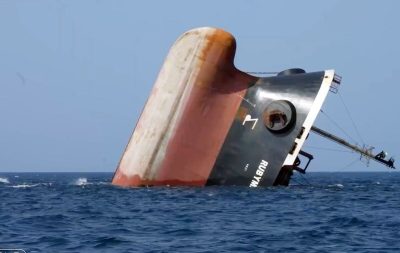The Houthis Are Schooling Us in Asymmetric Warfare

The Houthis of Yemen think they’re at war with the West. With the news that three undersea fiber-optic cables were severed off the Yemeni coast and that one of their ballistic missiles took lives for the first time upon striking a container ship, it’s time to acknowledge that we are at war with them. The much harder question is how to fight this kind of asymmetric foe.
What the Houthis are proving is that the developed West faces rising challenges on two fronts from weaker enemies, ranging from non-state actors to the likes of Iran and Russia. And for all the still-extraordinary power of US carrier fleets, the answer to those challenges can’t always boil down to just getting tougher, drawing lines and establishing deterrence – the standard Washington strategy.
The first challenge is that advances in the production of missiles and drones have democratized extremely powerful weapons that until recently were available only to the richest states. The suicide vest and improvised explosive device are being replaced by the suicide drone and precision-guided missile.
The second is a growing asymmetry of vulnerabilities. The Houthis are demonstrating in real time just how target-rich developed nations are. Wealthy, complex societies such as the US, which had a per capita gross domestic product above $76,000 at the end of last year, have a lot more to attack (and lose) than a nation such as Yemen, with per capita GDP of $650. In a globalized economy, much of the infrastructure supporting all that wealth creation is offshore.
So when the Houthis disrupt the roughly 12% of global shipping that passes through the Bab al-Mandab strait between the Arabian peninsula and the Horn of Africa, it impacts consumers in Europe and manufacturers in Asia, but not Yemen. If oil tankers have to shift to longer, more expensive routes than the Suez Canal, nudging up the price of gasoline at US pumps, the Houthis will be much less affected. The same goes for attacking the dozen or more international submarine data cables that run through the same strait. Meanwhile, if the Houthis kill US troops or citizens, that’s a political problem for the Biden administration. If the US kills Houthi civilians, that’s a political boon for the Houthis — as Hamas has proved in Gaza.
It still isn’t clear how the three Red Sea cables were damaged. The Ministry of Telecommunications in Sana’a has denied Houthi involvement. The US has assessed the most likely explanation is that the Rubymar, a British-owned container vessel that was floating aimlessly after being struck by a Houthi missile, may have dragged its anchor across the cables last week, before finally sinking.
Either way, this is a teachable moment. Submarine cables often are damaged by fishing trawlers or weather events, and quickly repaired. What’s telling in this case is the difficulty that operators are having in getting $60 million-plus repair ships out to restore the connections in a war zone.
While the risks can be overdone – there is a good deal of redundancy in the system — intercontinental data cables are critical infrastructure. Trillions of dollars pass through these small fiber-optic highways every day, not to mention communications and the data that sophisticated militaries rely on to operate. The incident in the Red Sea has given just a glimpse of what might happen if they were taken out by a determined foe in a context of war, just as Britain attacked Germany’s undersea telegraph cables at the start of World War I.
“This is where you see the interests of industry and people that have to deal with security diverge,” says Justin Sherman, a non-resident fellow at the Atlantic Council think tank, and chief executive officer of Global Cyber Strategies, a Washington-based advisory company. Virtually all submarine cables are laid and operated by private companies focused less on maximizing security than minimizing cost. There’s nothing wrong with that — it’s the commercial incentive that got the cables built.
The result, though, is that cables tend to be laid in bundles; the places they land are public, and they’re often also gathered together to reduce costs; security is usually minimal. All of that is ideal for anyone bent on causing a catastrophic disruption. There may not have been a confirmed case of a hostile state cutting another’s cable connections in recent years – these things are hard to prove — but so long as countries believe they’re at war, it will happen.
What’s striking about maps of the world’s roughly 1 million miles of submarine cable is what they say about relative dependencies. As a large continental power that spans from Europe to the Far East, Russia has just a handful of short hop undersea cable connections. Yet it has for years been developing one of the world’s largest surface and subsurface naval capabilities for reaching and monitoring, or potentially tapping and destroying them. Russia has, of course, plenty of fiber-optic cables of its own, but these are on land.
The smart move is to reduce our vulnerabilities. In the case of undersea cables, that means increasing resilience through redundancy; beefing up security at landing stations, as well as in the web-based – and therefore open-to-hacking – monitoring programs used by commercial operators. Governments should also develop legal frameworks to push companies to design more security into new cable systems. All of this has been known for years – British Prime Minister Rishi Sunak wrote a paper on the subject in 2017, when he was just an MP.
In the meantime, the US should resist the temptation to escalate its fight with the Houthis. The temporary loss of the Suez Canal shipping route until the war in Gaza ends is a cost the global economy can survive. Targeting mobile missile launchers was always going to be a game of whack-a-mole, unlikely to deter the Houthis because being attacked by “the Great Satan” works well for them politically. They claim to have been flooded with tens of thousands of new recruits since.
To have a real chance of ending the Houthi threat to international shipping – or indeed cables – the US Navy would have to target Houthi command and control centers in Sana’a and other urban areas, inevitably causing civilian casualties that would only add to US troubles in the Middle East. To reliably succeed would demand a full invasion. Neither option would be remotely worth the cost. (Bloomberg)

